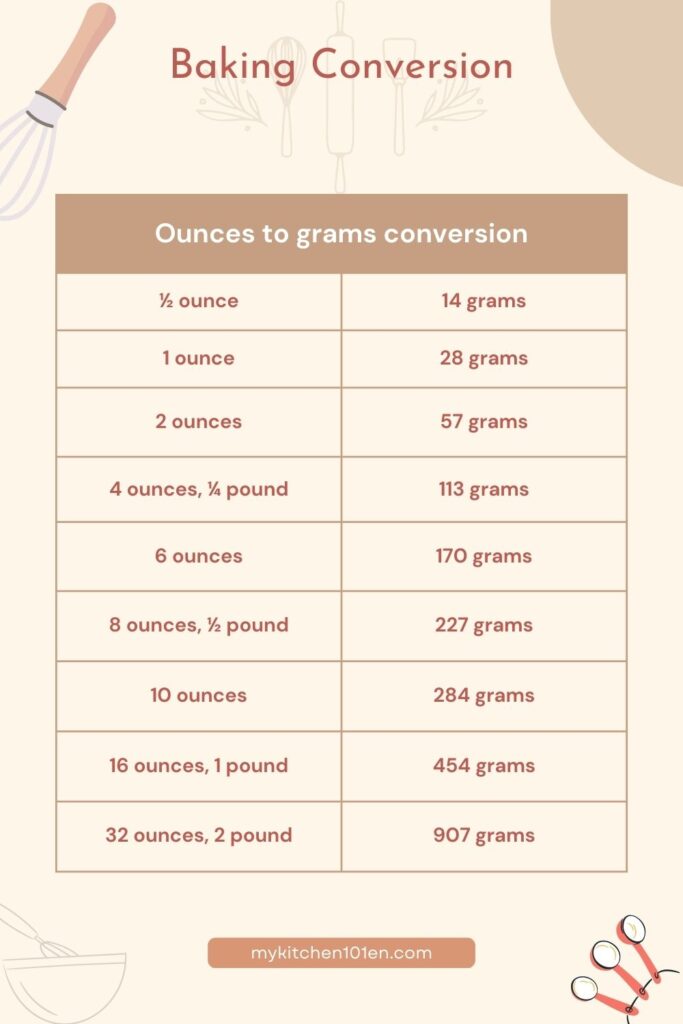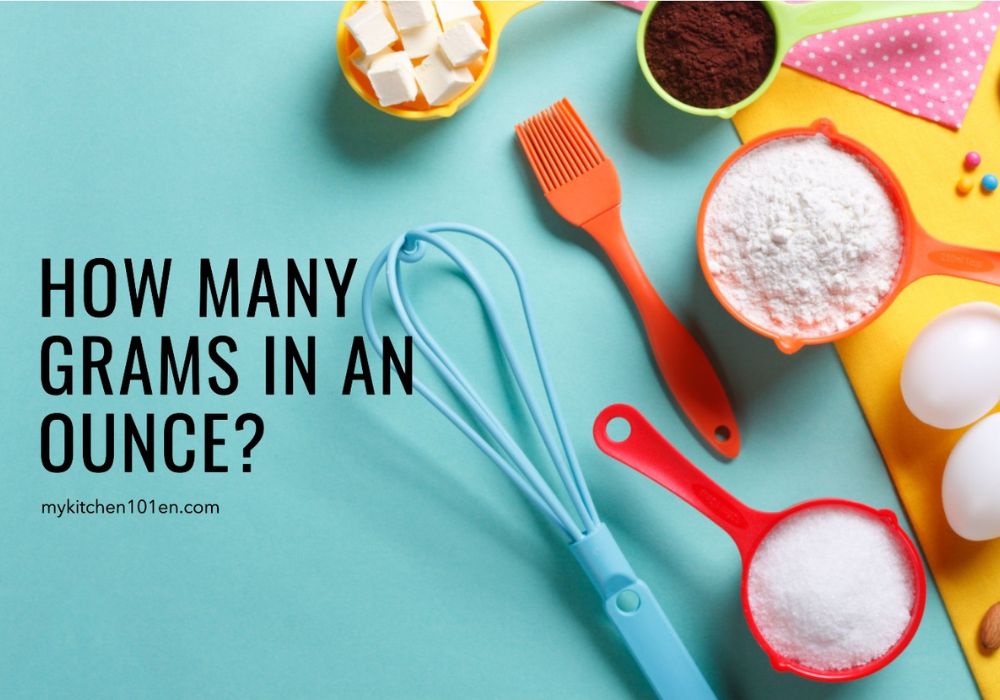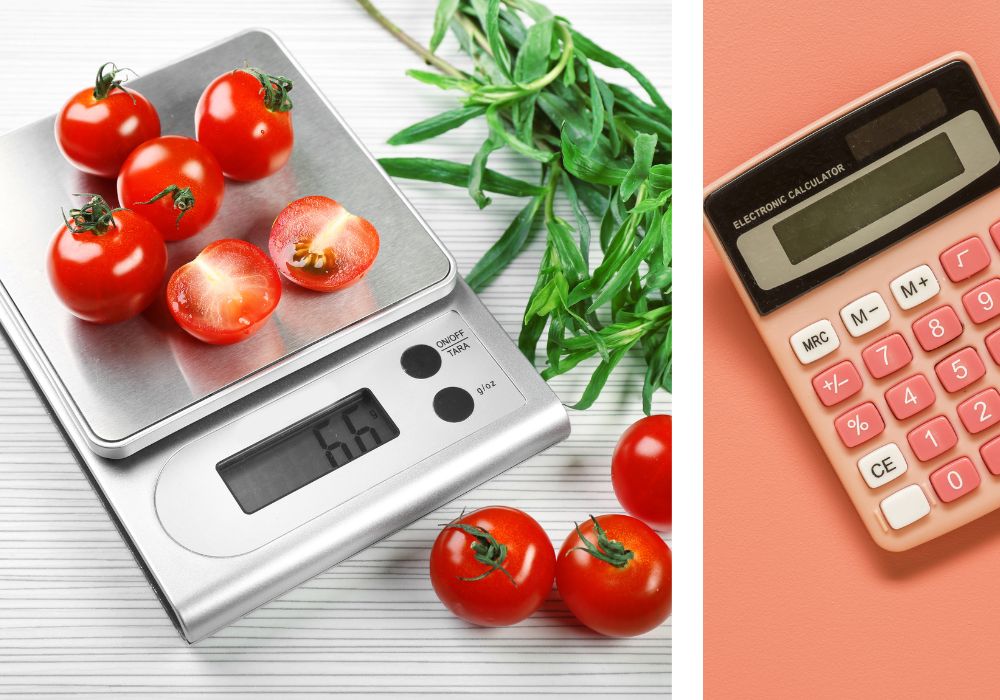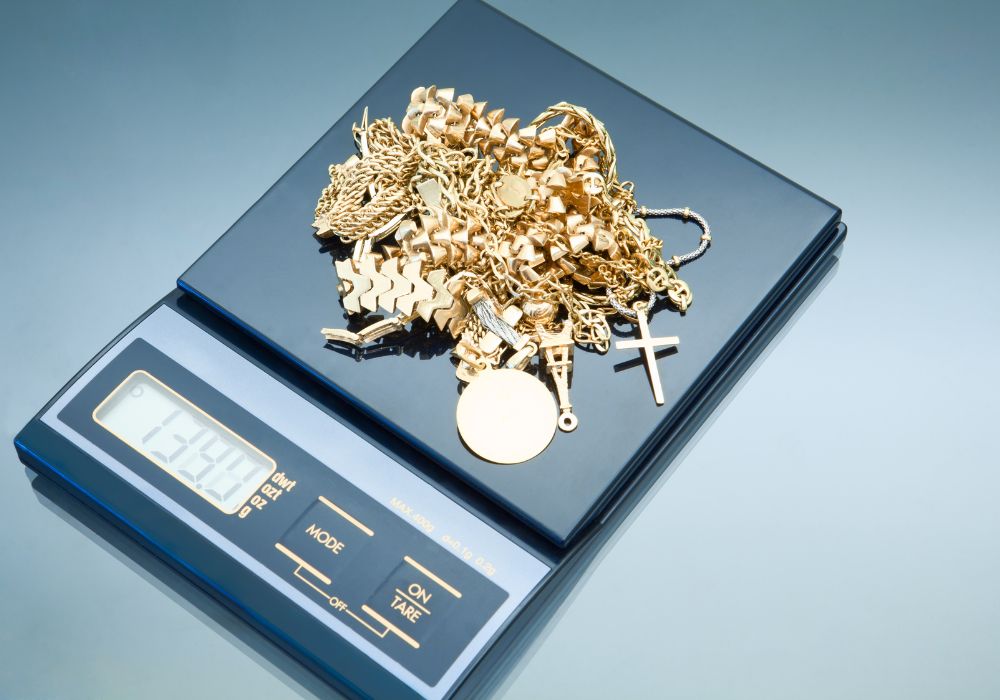Have you ever encountered a situation, such as cooking a recipe with measurements given only in grams, where you needed to know the equivalent weight in ounces? Or perhaps all you had at home were measuring cups and not their equivalent measurement scales. No matter what the reason is, knowing how many grams there are in an ounce can always come in handy!
The conversion rate between grams and ounces is important because it helps us make accurate measurements. While ounces are commonly used throughout the United States for weight measurements, other countries have adopted the metric system and used grams instead.
This sometimes causes confusion when recipes or product listings provide measurements using one system while we’re only familiar with the other.
Now that we’ve established why knowing this conversion rate matters let’s dive into what exactly an ounce and gram are and their origins.
Table of Contents
[ads1]
Conversion Table: Key Takeaways
To convert ounces to grams, simply multiply the number of ounces by 28.3495 and round up to the nearest whole number. The above table provides a quick reference for some common ounce-to-gram conversions.

Related:
- Converting Ounces to Cups
- How Many Teaspoons in a Tablespoon?
- How Many Liters in a Gallon: Liter to Gallon Conversions Guide
What is an Ounce?
The Versatile Unit of Measurement
It is a unit of mass or weight that is equivalent to 28.35 grams. Ounces are used in many different industries, including cooking and jewelry making. In the US, it’s often written as “Oz.” while in other countries, it may be written as “oz.”
The History and Origin of the Measurement
The word “ounce” originates from the Latin word “uncia,” which means one-twelfth part. The ancient Romans used this term to describe a small unit of weight or volume in recipes for cooking and medicine.
The ounce was then adopted by medieval Europe as a standard unit of measurement for various commodities such as grain, metals, and spices.
In 1824, Britain standardized its weights and measures system by defining the avoirdupois pound as containing 16 ounces. This definition has since been widely accepted throughout the world and often used interchangeably with other systems like metric units.
Common Uses for Ounces
One common use for ounces today is measuring ingredients in cooking recipes. Ingredients like flour, sugar, and butter are often measured by ounces, or sometimes using cups or spoons.
Ounces are also commonly used in precious metal trading to measure gold or silver bullion.
Overall, knowing what an ounce is and its common uses can be helpful in many different areas of life. Whether you’re measuring ingredients for your favorite recipe or trying to weigh out some gold bullion – understanding this unit will serve you well!
What is a Gram?
A gram is a unit of measurement commonly used to quantify the weight of an object or substance. The symbol used to represent grams is “g”.
Define what a gram is and its common uses
Grams are often used in cooking and baking recipes to measure ingredients such as sugar, flour, and spices.
In the field of medicine, milligrams are often used to measure the weight of medications and dosages. One milligram (mg) is one-thousandth of a gram. It is a small unit of measurement often used for weighing and describing very small quantities, such as the active ingredients in medications, nutritional supplements, or chemicals in scientific research.
Discuss the history and origin of the measurement
The gram was officially adopted by France as a unit of measurement in 1795 during the French Revolution. It was based on the weight of one cubic centimeter (cc) or milliliter (mL) of water at its maximum density at 4°Celsius.
This definition made it easier for scientists worldwide to standardize their measurements. Prior to this definition, different cultures had their methods for measuring weight using various objects such as grains or seeds.
In ancient Greece, for example, one talent was equal to sixty minas and one mina was equal to sixty drachmas; each drachma weighed approximately 4.37 grams.
Understanding what a gram is and how it’s commonly used can be helpful in everyday life whether you’re cooking up your favorite dish or measuring out medication for a loved one. The gram has a rich history dating back to the French Revolution and continues to be an important unit of measurement in many fields today.
How Many Grams are in an Ounce?

When converting between ounces and grams, knowing the exact conversion rate is essential, as ounces are commonly used in the US, and grams are predominantly used worldwide.
[ads1]
The Exact Conversion Rate
To convert ounces to grams, you need to know the formula. The conversion is 1 ounce = 28.349523125 grams.
It’s important to note that this number is not rounded—all decimals are significant, which means even the smallest difference can result in a large discrepancy when measuring larger quantities of substances.
For example, if you’re trying to convert 8 ounces of flour into grams for a recipe, using the rounded conversion rate of 1 ounce = 28 grams would result in an inaccurate measurement of 224 grams (8 x 28).
However, using the exact conversion rate would provide a more accurate measurement of 226.796 grams (8 x 28.3495).
A Handy Conversion Table
To make things easier, here’s a handy conversion table for some common ounce-to-gram conversions:
| Ounces (oz) | Grams (g) |
|---|---|
| 0.5 | 14 |
| 1.0 | 28 |
| 2.0 | 57 |
| 4.0 | 113 |
| 6.0 | 170 |
| 8.0 | 227 |
| 10.0 | 284 |
| 16.0 | 454 |
| 32.0 | 907 |
Remember, this table is for avoirdupois ounces, which are used for most everyday items. For precious metals measured in troy ounces, use the conversion factor of 31.1035 instead.
Why This Conversion Rate is Important
Knowing how many grams are in an ounce can be extremely useful for various tasks such as cooking and baking.
For instance, if a recipe calls for 50g of flour but all you have at home is measuring scale with ounces, knowing that one ounce is equivalent to 28.35g will allow you to measure out roughly 1.76 ounces of flour without having to guess or estimate. This level of precision can make all the difference when cooking or baking and can prevent your dish from turning out too dry or too wet.
Knowing the exact conversion rate between ounces and grams can eliminate any potential errors that may arise during measurements.
How to Use Weight Conversion Tools

Learning to use weight conversion tools effectively is an essential skill for many everyday tasks. These tools will give you accurate results every time–and they’re easy enough for anyone with basic math skills (or even no math skills) who wants an easy way out of doing calculations manually every time they need them!
- Using a weight conversion calculator
- Input the value you want to convert.
- Select the original unit (e.g., ounces, grams, pounds, or kilograms).
- Choose the unit you want to convert to.
- Click “Convert” or “Calculate” to display the result.
- Using kitchen scales
- Place the scale on a flat, stable surface.
- Turn on the scale and select the desired unit by pressing the “unit” button.
- Tare the scale by placing an empty container or wax paper on it and pressing the “tare” or “zero” button.
- Add the item you want to weigh until you reach the desired weight.
- If necessary, switch to a different unit by pressing the “unit” button again. The scale will automatically convert the weight to the selected unit.
- Using weight conversion apps and online services
- Download a weight conversion app on your smartphone or tablet, or visit a weight conversion website.
- Input the value you want to convert.
- Choose the original unit and the unit you want to convert to.
- The app or online service will automatically calculate the conversion and display the result.
Common Uses for Knowing How Many Grams Are in an Ounce
The Importance of Knowing the Conversion Rate
The ability to convert between various units of measurement is vital across several industries. For example, knowing how many grams are in an ounce can make or break a recipe—or determine the value of a piece of jewelry.
Cooking and Baking
In the culinary world, measurements are everything. A slight miscalculation can ruin an entire dish. Knowing how many grams are in an ounce is particularly important when it comes to baking.
Recipes often call for ingredients measured in ounces or grams, and converting between the two can be challenging without this knowledge. For example, let’s say you’re making macarons and your recipe calls for 4 ounces of almond flour – that’s equivalent to about 113 grams.
Jewelry Making
Jewelry makers also rely heavily on their ability to convert between ounces and grams. Precious metals like gold and silver are sold by weight, typically measured in troy ounces which differ slightly from regular ounces (31.1 grams per troy ounce).
In order to determine the value of a piece they’re creating or selling, jewelers need to know exactly how much metal they’re working with.

Fun Facts about Grams and Ounces
Grams and Ounces Have Different Names in Other Languages
Did you know that the term “gram” comes from the Greek word “gramma,” which means small weight? And in Spanish, “gram” is spelled “gramo.”
On the other hand, “ounce” comes from the Latin word “uncia,” which means one-twelfth. In French, an ounce is called a “once.”
It’s fascinating to think about how different languages have their way of naming these measurements.
An Ounce of Gold vs. An Ounce of Feathers
You might have heard this age-old riddle before – what weighs more: an ounce of gold or an ounce of feathers?
The answer is that both weigh the same!
An ounce of feathers takes up much more space than an ounce of gold because gold is denser.
By learning fun facts like these about grams and ounces, we can learn to appreciate how much precision and accuracy go into the measurements we use every day. So, the next time you weigh out ingredients for your recipe, keep in mind these interesting tidbits about grams and ounces!
Remembering the Conversion Rate: Key Takeaways
Converting between weight units is simpler now than in the past. You’ll be surprised by how quickly you pick up the calculations if you have a calculator or mobile phone handy. After going over some key facts, remember these important points:
Firstly, an ounce is a unit of measurement commonly used in the United States, as well as in some other countries. One ounce equals 28.35 grams, and this conversion rate is frequently used in various industries.
When cooking international recipes or working with foreign ingredients, knowing how many grams are in an ounce can make a big difference in terms of accuracy and taste.
Remembering the conversion rate between grams and ounces is crucial for anyone who works with weights or measurements regularly. Whether you’re a professional chef or just someone who enjoys cooking at home, understanding this basic calculation can save time and improve your results. So be sure to keep this information handy the next time you need it!
FAQs
How many grams are in an ounce?
One avoirdupois ounce (the most common ounce used) is equal to approximately 28.35 grams.
What is the difference between an avoirdupois ounce and a troy ounce?
An avoirdupois ounce is the standard unit of weight used for most everyday items, while a troy ounce is typically used for measuring precious metals like gold and silver. One troy ounce is equal to approximately 31.10 grams.
How do I convert ounces to grams?
To convert ounces to grams, multiply the number of ounces by 28.35 (for avoirdupois ounces) or 31.10 (for troy ounces).
How do I convert grams to ounces?
To convert grams to ounces, divide the number of grams by 28.35 (for avoirdupois ounces) or 31.10 (for troy ounces).
What tools can I use to convert between ounces and grams?
You can use online weight conversion calculators, kitchen scales with multiple unit options, or weight conversion apps and websites.
Why is it important to know how many grams are in an ounce?
Knowing the conversion between ounces and grams is essential for various tasks, such as cooking, baking, shopping, pharmaceutical dosages, and scientific research, among others.
How do I measure weight in ounces using a kitchen scale?
Place the scale on a flat surface, turn it on, and select the “ounce” unit. Tare the scale with an empty container or wax paper, then add the item you want to weigh until you reach the desired number of ounces.
Can I use the same conversion rate for both liquid and dry ounces?
No, the conversion rate between grams and ounces mentioned in this FAQ applies to dry weight measurements (avoirdupois ounces) only. Liquid ounces are a measure of volume, and you’ll need to use a separate conversion rate for fluid ounces to milliliters.
How do I convert between ounces and grams when using a recipe from another country?
Use a weight conversion calculator or app to convert the measurements in the recipe. For example, if the recipe calls for 8 ounces of flour and you need to convert it to grams, multiply 8 by 28.35 to get approximately 226.8 grams.
Are there any other weight units I should be aware of when converting between ounces and grams?
While ounces and grams are the most common units for weight conversion, there are other weight units such as pounds and kilograms. Familiarize yourself with these units and their conversion rates to ensure accurate measurements in various situations.
How many grams in an ounce of butter?
There are approximately 28.35 grams in an ounce. So, in an ounce of butter, there would be the same, which is 28.35 grams.
How many grams of protein in an ounce of steak?
The amount of protein in an ounce of steak can vary depending on the cut and how it’s cooked. On average, there are around 7 grams of protein in an ounce of cooked steak. Keep in mind that factors such as the type of steak, cooking method, and degree of doneness can affect the protein content.




